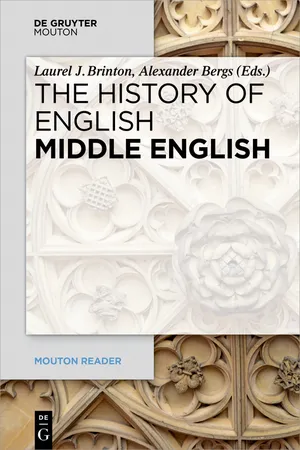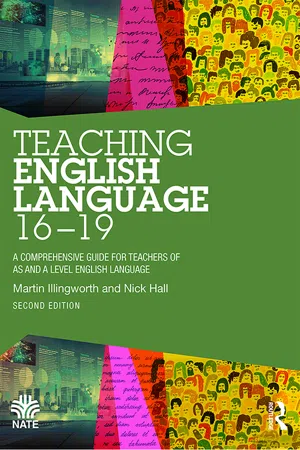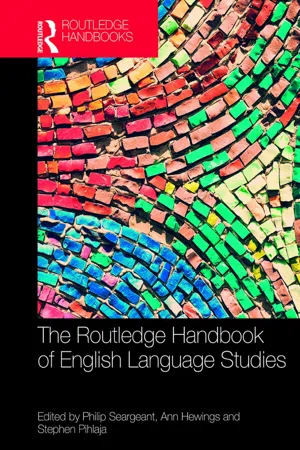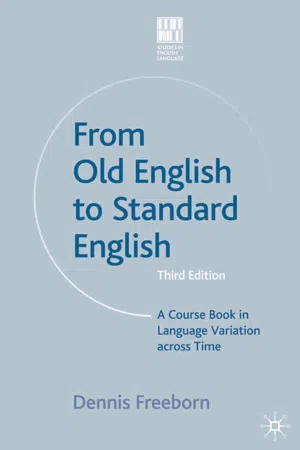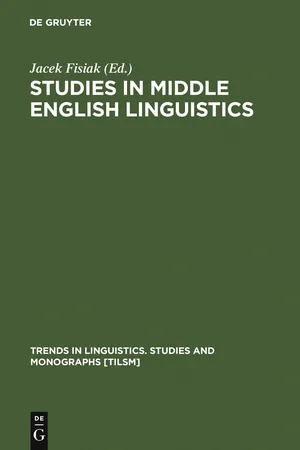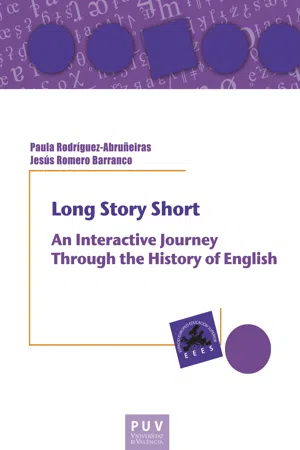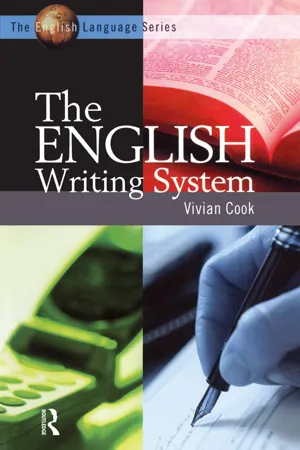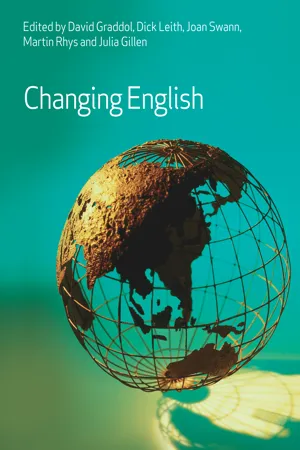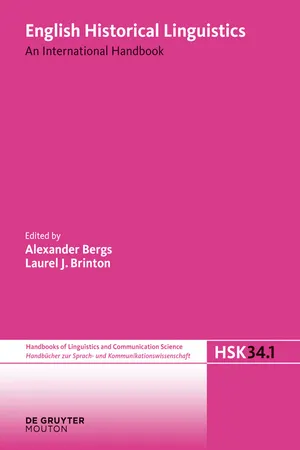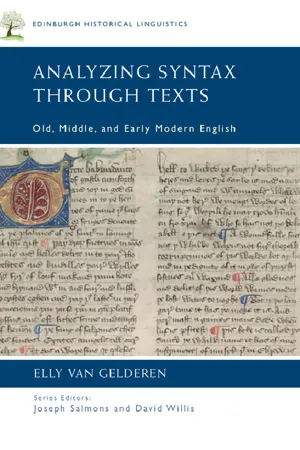Languages & Linguistics
Middle English Examples
Middle English examples refer to written or spoken texts from the period of English language development between the 12th and 15th centuries. This era saw the evolution of English from Old English to the language we recognize today. Middle English examples include works such as Geoffrey Chaucer's "The Canterbury Tales" and the Wycliffe Bible, which showcase the linguistic transition during this time.
Written by Perlego with AI-assistance
Related key terms
1 of 5
11 Key excerpts on "Middle English Examples"
- eBook - ePub
- Laurel Brinton, Alexander Bergs, Laurel Brinton, Alexander Bergs(Authors)
- 2017(Publication Date)
- De Gruyter Mouton(Publisher)
Jeremy J. Smith Chapter 2: Middle English: Overview Jeremy J. Smith: Glasgow (UK) 1 What is Middle English? 2 Issues of evidence 3 Writing and speech 4 Grammar 5 Lexicon 6 Summary 7 References Abstract : Middle English is the period in the history of English when variation is most thoroughly recorded in the spoken mode, and the body of surviving material is very large. In this chapter, the extralinguistic reasons for the survival of variation in Middle English are given, focusing on the relationship between linguistic form and socio-cultural function. Middle English has come down to us directly through manuscripts, and indirectly through reconstruction and through the study of residualisms in Present-day English; the reliability of the evidence for Middle English is assessed. Each level of language in turn is then discussed: writing- and speech-systems (= transmission), grammar, and lexicon. New resources (especially online) for the study of Middle English are flagged, offering exciting possibilities for future research. The aim of the chapter is to offer both a characterization of Middle English itself and a sketch of the resources available for its study. 1 What is Middle English? Middle English (ME) is the form of English spoken and written roughly between 1100 and 1500 CE. Its beginning roughly corresponds to the Norman Conquest of 1066, while its end roughly corresponds to the first book printed in English (1475) and the arrival of printing in England (1476): these two historical events, though of very different kinds, have implications for the status of the language during the Middle English period. Up until the Norman Conquest, English (i.e. Old English) had a distinct status as a language of record and for literary expression; it developed a written standardized form, classical Late West Saxon, which was used by scribes outside its area of origin, i.e. Wessex in south-west England - eBook - PDF
Current Explorations in Middle English
Selected papers from the 10th International Conference on Middle English (ICOME), University of Stavanger, Norway, 2017
- Merja Stenroos, Martti Mäkinen, Kjetil Vikhamar Thengs, Oliver Martin Traxel(Authors)
- 2019(Publication Date)
- Peter Lang Group(Publisher)
There are innumer- able examples of texts that have been edited, emended and prepared for use by a modern audience. While these deal with authentic material there are other cases where texts give merely an impression of belonging to this language stage: they draw on earlier material to create something new with an archaic twist. This paper gives an overview of the different categories where we encounter Middle English in modern contexts and illustrates these on the basis of some examples, mainly focusing on the Present-Day English period (the twentieth and twenty-first centuries). The aim is to establish a fixed terminology for the various phenomena which can be used in future academic studies. Keywords: linguistic creativity, medievalism, modern takes on Middle English, Present- Day English, terminologies 1 Introduction The representation and interpretation of the Middle Ages is no new phenom- enon. Already during the Renaissance do we find numerous authors whose works were inspired by medieval history and literature, the best known of which is no doubt William Shakespeare (Perry – Watkins 2009). There are countless modern depictions of this period, as can be seen, for example, in the large number of historical novels and films issued in recent years. Besides such primary evidence there are also scholarly organisations (e.g. the International Society for the Study of Medievalism), 1 websites (e.g. Medieval Electronic Multimedia Organization) and regular specialist conferences (e.g. The Middle Ages in the Modern World) that examine such occurrences. The academic discipline of medievalism thrives, and several monographs and periodicals are dedicated to this subject. These cover a wide range of fields, such as history, literature, culture and media studies, but surprisingly there are hardly any works on linguistic issues. - eBook - ePub
Teaching English Language 16-19
A Comprehensive Guide for Teachers of AS and A Level English Language
- Martin Illingworth, Nick Hall(Authors)
- 2018(Publication Date)
- Routledge(Publisher)
As well as these ‘internal’ features of the texts of Old English, you could discuss with your group how they feel about having become detached from the origins of their language. I would suggest that most merely feel that it is mildly irritating not to be able to read texts in museums. It perhaps makes the past feel even more distant and strange. You might reflect with your class upon the plight of languages which are becoming extinct, subsumed by bigger languages like English. For example, the last speaker of the language Kasabe, spoken in Cameroon, died in November of 1996 before the language had been documented by linguists (there are many languages in the world that do not have a written form). It would surely be more than ‘mildly irritating’ if that speaker were a relative of yours and he took with him all of your family history. Languages are the repositories of history, the gateposts to identity and cultural understanding.Middle English Period 1150–1500AD
The Canterbury Tales , Geoffrey Chaucer. Chaucer is an important writer for linguistic study because of the sheer range of voices portrayed in his choice of characters on their pilgrimage to Canterbury from London. Chaucer chose his characters from all walks of life and they bring with them the multiplicity of accents, dialects, high-brow foreign borrowings and earthy Anglo-Saxon vocabulary.The Lord’s Prayer . It can be useful to contrast your Old English version of The Lord’s Prayer (above) with a Middle English version. This makes a good introduction to the ways in which the language has moved on between the two general time periods. Students will undoubtedly note that this text is much more accessible. So, you explore why they can now, not only identify the text, but fully understand it.Oure fadir that art in heuenys, Halewid be thy name. Thy kingdom come to, Be-thy wille don as in heuene an in erthe. Give to us this day oure breed ouer other substaunse, And furgiue to us oure dettouris, And leede us not into temptacioun, But delyuere us from yuel. Amen.Piers Plowman , William Langland. In a period when the English language had made extensive borrowings from French, Langland’s verse is notably lacking in such borrowings. This text deals with the plight of the working classes of the Midlands area and is written in alliterative verse making use of the voice of the peasant classes. For the linguist, this text is a good reminder that each text must be considered on its own merits rather than general notions of what one might expect to see in a text written in 1390.__________________________________This period is dominated by the invasion of the Norman French in 1066. English became a second-, or indeed third-class language in its own country behind the French of the ruling classes and the language of learning and religion, Latin. Writing in English all but disappears after the Norman Conquest until around 1200. English became an oral language, not thought fitting for serious and important matters. - Philip Seargeant, Ann Hewings, Stephen Pihlaja, Philip Seargeant, Ann Hewings, Stephen Pihlaja(Authors)
- 2018(Publication Date)
- Routledge(Publisher)
Another way in which the application of modern linguistic methods has revolutionised the historical study of English is in the field of dialectology. As we saw above, the historical study of English had previously focused heavily on the evolution of the standard language, ignoring the rich evidence for the history of English dialects. This evidence is particularly plentiful in the Middle English period, since there was no standard variety of the written language. For this reason, changes in the methods of historical dialectology in the light of modern approaches are best illustrated by a consideration of the work of the Middle English Dialect Project. This project was instigated by M.L. Samuels and A.I. McIntosh of the universities of Glasgow and Edinburgh respectively, in the 1950s. Drawing on methodological insights from the linguistic survey of the Modern Scots dialects, they set out to produce an atlas of the dialects represented by the Middle English written record. Despite being restricted to exclusively written materials, the Middle English Dialect project proceeded on the assumption that written variation could be subject to dialect mapping in precisely the same manner as had been achieved with spoken differences in the Modern Scots dialect survey. In seeking to apply modern dialectological techniques to the Middle English dialects, the project encountered a number of challenges. An obvious limitation imposed by the sources concerned the lack of access to the spoken language: a problem that affects all historical studies that pre-date the invention of audio recording technology. As well as lacking direct access to the spoken language, the Middle English dialect survey was limited by the lack of localised documents – most Middle English manuscripts were written by anonymous scribes and do not preserve important information about the date or location of their copying. The survey overcame this limitation by developing the ‘fit-technique’; manuscripts were ‘fitted’ on the dialect map by comparing their linguistic forms with those recorded in manuscripts where the location of copying was known (‘localised’ or ‘anchor’ texts) (Benskin 1991). The result of this was the localisation of around 1,000 manuscripts copied in the period between 1350 and 1450, accompanied by extensive linguistic profiles of representative data and schematic maps indicating the distribution of representative linguistic items (McIntosh et al. 1986).- eBook - PDF
From Old English to Standard English
A Course Book in Language Variations Across Time
- Dennis Freeborn(Author)
- 2017(Publication Date)
- Red Globe Press(Publisher)
5 From Old English to Middle English 5.1 The evidence for linguistic change The ways in which we have identified and described features of the language in the Old English texts in Chapters 1–4 are those that we can systematically apply to any text of English. We look for: ● Changes in spelling conventions, letter forms and the alphabet used. These are our only guide in OE and ME texts to the pronunciation of the language. ● Changes in pronunciation , inferred from the written words. ● Changes in word structure , suffixes (inflections) and prefixes. ● Changes in the grammar and word order. ● Changes in the word-stock or vocabulary – new words appear, old ones are no longer used. We call the language from about 1150 to 1450 Middle English (ME), because from our point of view in time it comes between the periods of Old and Modern English. The evidence for change and development in ME, before the first printing press was set up by William Caxton in 1476, lies in written manuscripts, just as for OE. Every copy of a book, letter, will or charter had to be written out by hand, but only a few of the existing manuscripts in ME are originals, in the hand of their author. Many copies of a popular book like Chaucer’s Canterbury Tales , for example, have survived, though Chaucer’s original manuscripts have been lost. On the other hand, other works are known through a single surviving copy only. As a result of the social and political upheaval caused by the Norman Conquest (see section 5.2, following), the West Saxon standard system of spelling and punctuation was in time no longer used. Writers used spellings that tended to match the pronunciation of their spoken dialect. Scribes often changed the spelling of words they were copying to match their own dialectal pronunciation. After several copies, the writing might contain a mixture of different dialectal forms. - eBook - PDF
- Jacek Fisiak(Author)
- 2011(Publication Date)
- De Gruyter Mouton(Publisher)
When did Middle English begin? Later than you think! Peter R. Kitson One of the aspects of Middle English about which there has been least general agreement is when it began. Partly this depends on how exactly you define the periods of English. Henry Sweet in his pioneering classifi-cation (1874: 157-161) was very clear about this. To him Old English is the period of full inflections ( nama, gifan, caru ), Middle English of levelled inflections ( naame, given, caare) (1874: 160). It is plain from his example and his preceding discussion (1874: 52; cf. 29-30, 55-56) that what he meant was the existence or not of a variety of vowels in un-stressed inflectional syllables. Of course the loss of variety was not in-stantaneous. Sweet's first History offers no exact chronologies except for Modern English (1874: 56), but he has a good deal to say about the linguistic processes of the transition from Old to Middle (1874: 38-40), implying that it took a substantial period; he refers roughly (1874: 39) to the Transition English of the twelfth century. By the time of his New English Grammar he had schematized that, giving Late Old English 900-1100, Early Middle English 1200-1300, and Transition Old Eng-lish the whole century 1100-1200. In keeping with his definition, he characterizes the language of Lajamon, in which some variety of inflec-tional vowels remains, as not Early Middle but Transition Old English (1892: 211). More recent writers have tended either to prefer a tidy join between Old English and Middle English, or at least to shorten the transi-tional period if they allow one, and put the start of Middle English earlier. Sweet himself in the second edition of his History gave them their lead. There he dates fully developed ME ... from 1150, while The period from 1050 to 1150 may be distinguished as Old Transition (1888: 154). We should note that this was four years earlier than the New English Grammar, and is inconsistent in its treatment of La3amon, whose older ms. - eBook - PDF
Long Story Short:
An Interactive Journey through the History of English
- Paula Rodríguez Abruñeiras, Jesús Romero Barranco(Authors)
- 2021(Publication Date)
- Publicacions de la Universitat de València(Publisher)
4.2. THE CONSTRUCTION OF MIDDLE ENGLISH ISOGLOSSES AND THE EMERGENCE OF A NEW STANDARD Variation in the Middle Ages was notorious from different standpoints: level of linguistic analysis (morphology, phonology, syntax, etc.), geographic area and date of composition (“texts from different areas are different, and later texts differ very markedly from earlier ones”, Milroy 1992: 156). Before the invention of the printing press, copies of the same text were made by scribes in different parts of England, and those scribes would capture the main linguistic features of their own variety of English in their production. Five main ME varieties can be distinguished up to the emergence of a standard in the 15 th century. From least to most conservative these are Northern, West midland, East Midland, Southern and Kentish. The different dialects spoken in England were not always mutually intelligible, and speakers would usually regard theirs as the superior variety, as can be seen in the passages below: Excerpt 3. Cursor Mundi , by Richard Morris ( Corpus of Middle English Prose and Verse ; https://quod.lib.umich.edu/c/cme/AJT8128.0001.001/1:4.1.128?rgn=div3;view=fulltext) ME In sotherin englis was it draun, And turnd it haue i till our aun Word by word translation (our own) In southern English it was written And translated have I to our own Scan the following QR code to see a map of ME dialectal areas (also available at https://historyofenglishpodcast.com/2018/06/08/episode-112-northern-messenger/) Long Story Short: An Interactive Journey thorugh the History of English 101 Langage o northrin lede, þat can nan oiþer englis rede. 20064 Language of northern people, Who cannot other English read. Excerpt 4 . Gesta Pontificum Anglorum (Latin for Deeds of the Bishops of the English ), by William of Malmesbury, early 12 th century (Ruano-García 2008: 56). - eBook - ePub
- Vivian J Cook(Author)
- 2014(Publication Date)
- Routledge(Publisher)
The only punctuation marks in Middle English consisted of ‘a low dot, an inverted semicolon and a virgule (/)’ (Strang 1970: 159), used to indicate lengths of pause — short, medium and long. Like Old English, ME was correspondence-based rather than grammatically based and lacked marks such as the question mark and the exclamation mark that indicate grammatical punctuation. The normalized texts are therefore imposing a punctuation system on Middle English; the original ME writing system is being sacrificed to the convenience of a modern reader. 6.4 From Early Modern English to Modern English Early Modern English refers to English between about 1500 and 1700. The first printed books in English came just before the start of this period, coming from the first English printers established by William Caxton in 1477. Most of the subsequent history of the English writing system has concerned the printed word rather than the hand-written word. To a large extent, Early Modern English writing was standardized across the different regions of England, Scotland and Wales, though there were considerable changes in the spoken language over this period. It is often said that the pressure to standardize the spelling came from printers, whose descendants still play this role in modern times, as seen in Chapter 4. Brengelmann (1980) argues, however, that Elizabethan writers would have insisted that their views took precedence over those of any printing hack and that standardized spelling worked against printers by depriving them of flexible alternative spellings of words. For example, few of the actual spellings introduced by William Caxton have come down to Modern English - eBook - ePub
- David Graddol, Dick Leith, Joan Swann, Martin Rhys, Julia Gillen, David Graddol, Dick Leith, Joan Swann, Martin Rhys, Julia Gillen(Authors)
- 2020(Publication Date)
- Routledge(Publisher)
Englisc ('English') was first used to denote both people and language under his auspices.In the tenth century there was another revival of learning and literary activity, this time associated with the influential Benedictine monasteries. The scriptorium of the monastery at Winchester, producing texts in the West Saxon dialect, seems to have made considerable efforts to regularise spellings and this has been seen as a move in the direction of standardisation in English. (See another book in this series, Graddol et al, 2007, for further discussion of this issue).Most extant Old English manuscripts date from the late Old English period and they preserve, not only translations of learned Latin texts, but also an important body of vernacular literature in prose and poetry. Some of the poems are religious, following the example set by Caedmon, and others (such as Beowulf) stem from inherited Germanic traditions.So far we've looked at Old English: where it came from, what it was like, how certain aspects of it changed, and how the process of change might be explained. We now move on to a different period of the English language, that known as 'Middle English'.2.6 The transition to Middle EnglishWe have seen that the English language was undergoing significant change during the early part of the tenth century. In 1066 an event occurred that was to have a profound effect on this process. In that year a French-speaking dynasty from the dukedom of Normandy was installed in England. This external event has long been seen as decisive, not only for the history of England (and consequently Britain) but for the English language as well. For scholars who have viewed the history of England and English as one of unbroken progress, the Conquest has often been a milestone on the road to 'civilisation', playing a key role in the development of Modern English. But another view, perhaps more widely held, sees the events of the Conquest in terms of (an at least temporary) decline: as the wrecking of a relatively sophisticated 'native' Anglo-Saxon culture by a 'foreign' and tyrannical French one, so that the continuity of English culture was ruptured and the continued existence of the English language threatened. - eBook - PDF
- Alexander Bergs, Laurel J. Brinton, Alexander Bergs, Laurel J. Brinton(Authors)
- 2012(Publication Date)
- De Gruyter Mouton(Publisher)
In many cases, especially of syntactic change, a polygenetic origin seems more plausible than a monocausal explanation. In any case, the extensive restructuring of Middle English cannot be explained without close linguistic contact. 32 Middle English: Language contact 505 Alex Bergs and Laurel Brinton 2012, Historical Linguistics of English (HSK 34.1), de Gruyter, 505 – 519 1 Introduction Speech communities hardly ever exist in isolation but have multiple contacts with other speech communities, with speakers of other languages and dialects, or with a culturally important “book” language. English has experienced a large number of such contacts with different ethnic and linguistic groups thoughout its history. From the beginning of their settlement, the Anglo-Saxons had contacts with speakers of Celtic languages, followed by contacts with Latin as the mainly written language of Christianity and cul-ture, and with the spoken Scandinavian languages (here referred to as Old Norse). Since the linguistic results of the early contacts with Celtic and Old Norse only surface in ME texts, they are included in this discussion of ME language contact. For the ME period, intensive contact with French is one of the most obvious features, though Latin also extended its role into new domains (see Townend 2006). Additionally, there was trade-related contact with Low German and Low Dutch. However, not all ME dialects nor their speakers experienced language contact to the same extent, and we also find extensive interdialectal contact, resulting e.g. in the spread of Northern and East Midland features into Southern dialects. Even a superficial comparison of Old and Middle English reveals dramatic linguis-tic changes: Old English was an inflected and largely synthetic language with a predo-minantly Germanic lexicon. - eBook - PDF
Analyzing Syntax through Texts
Old, Middle, and Early Modern English
- Elly van Gelderen(Author)
- 2017(Publication Date)
- Edinburgh University Press(Publisher)
English keeps changing, as we’ll see in the period after Middle English. Exercises A By now, we have talked about the following terms: analytic/synthetic, word order, V2, V-final, personal and demonstrative pronouns, relative and reflexive pronouns, auxiliaries, clause boundaries, and conjunctions. Pick two terms and discuss them with examples. B Look at the text below from Bede (Miller 1890: 186–70), whose punc -tuation and capitals I have kept, and try to provide a more idiomatic translation. Ða æt nehstan se cyning, se ðe Seaxna gereorde an cuðe, Then at last that king, DEM PRT Saxon language only knew wæs aðroten his elreordre spræce: aspon þa was tired his (=the bishop’s) foreign speech invited then in Westseaxe into Wessex oðerne biscop, se ðe his gereorde cuðe: other bishop DEM PRT his (=the king’s) language knew se wæs Wine haten & se wæs in Gallia rice gehalgod DEM was wine called and DEM was in Gaul kingdom consecrated Ond he þa todælde in twa biscopscire Westseaxna mægðe And he (=the king) then divided into two bishoprics Wessex people ond þæm Wine gesealde biscopseðl in Wintaceastre. and DEM Wine gave bishopseat in Winchester C Identify the verbs in the above text; which are auxiliary verbs and which are lexical? What rules do they follow: V2 or V-final, and are these as you’d predict? D List any personal, demonstrative, relative, and reflexive pronoun you recognize in the text. E Which are the conjunctions; are they coordinating or subordinating? Syntax of Old, Middle, and Early Modern English 43 F Discuss the use and morphological shape of the following: se in line 1, aspon in line 2, se in line 3, gehalgod in line 4, and þæm in line 6. G Discuss if the text in B is paratactic, hypotactic, or both. Further reading The 1980s saw a lot of work on the word order of Old English and how it differed from V2/OV languages such as Dutch and German, e.g.
Index pages curate the most relevant extracts from our library of academic textbooks. They’ve been created using an in-house natural language model (NLM), each adding context and meaning to key research topics.
